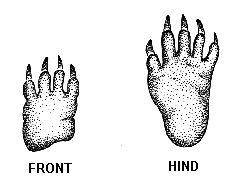
Porcupines
Erethizon dorsatum
Description
- The porcupine is a robust rodent that usually
weighs around 22 pounds. Its blunt-nosed face has small
eyes, and small, round ears. The legs are powerful with
long curved claws making it slow-footed and strong.
The front half of the porcupine's body is covered in
long guard hairs which are a yellowish colour in the
west and black or brown in the east. The rump and tail
are covered in over 30,000 quills which are 1-2.5 inches
in length and set with tiny, scalelike barbs.
Distribution - The porcupine occupies most of Canada
and all of British Columbia in coniferous forests in
the subalpine zone.
Biology - Mating habits of the porcupine are rather
bizarre; the male approaches the female with embraces
and nose-rubbing, if receptive, she allows him to spray
her with gouts of urine. When fully soaked copulation
occurs and 210 days later one offspring is born, sighted,
mobile and covered in hair and quills. The porcupine
feeds on leaves, twigs and green plants and has a ravenous
appetite for salt (it will chew on any salt stained
tools or clothes it comes across) and also it relishes
plywood because of the glue between the layers. Predators
of the porcupine include the fisher (mainly), the mountain
lion, bobcat, and the coyote.

Tracks - The tracks of the porcupine are easily
distinguished with pigeon-toed prints and a trough formed
by the dragging of their feet between. The tail quills
leave a pattern on the ground between these prints which
closely resemble the marks of a corn broom on dirt.
An oval shaped print with marks ahead from the long
claws is characteristic.
Straddle: 18 - 25 cm (7.2 - 10 in)
Stride: 12 - 16 cm (4.8 - 6.4 in)
Track: Front - 6 cm (2.4 in) long / 4 cm (1.6 in) wide
Track: Rear - 10 cm (4 in) long / 4 cm (1.6 in) wide


